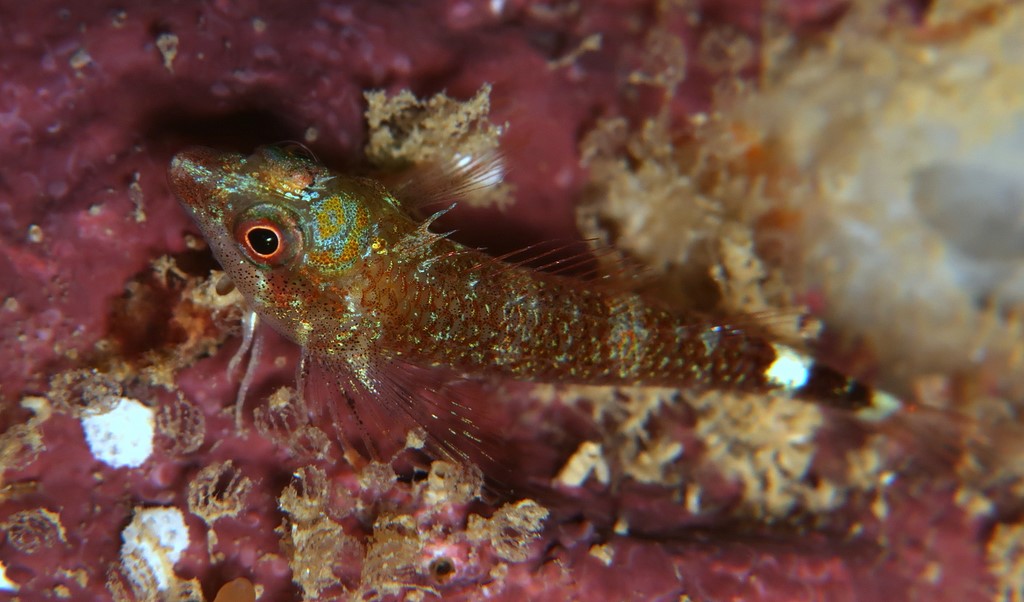ENNEAPTERYGIUS FLAVOCCIPITIS - (SHEN, 1994)
Picture courtesy of: Alain Daoulas
Actinopterygii (Gigaclass) > Actinopteri (Class) > Teleostei (Subclass) > Blenniiformes (Order) > Blennioidei (Suborder) > Tripterygiidae (Family) > Tripterygiinae (Subfamily) > Enneapterygius (Genus)
Twocolour threefin, Twocolor threefin, Northern bicolored triplefin, Northern bicoloured triplefin, Yellownape tripplefin, Erimakihebiginpo, エリマキヘビギンポ, 黃頂雙線鳚, 黃頂雙線鳚的異名,
Synonymes
Enneapterygius bichrous (Fricke, 1994)
Actinopterygii (Gigaclass) > Actinopteri (Class) > Teleostei (Subclass) > Blenniiformes (Order) > Blennioidei (Suborder) > Tripterygiidae (Family) > Tripterygiinae (Subfamily) > Enneapterygius (Genus)
Twocolour threefin, Twocolor threefin, Northern bicolored triplefin, Northern bicoloured triplefin, Yellownape tripplefin, Erimakihebiginpo, エリマキヘビギンポ, 黃頂雙線鳚, 黃頂雙線鳚的異名,
Synonymes
Enneapterygius bichrous (Fricke, 1994)
Enneapterygius rubicauda (Shen, 1994)
------------------------
Description
First dorsal spines (total): 3; Dorsal spines (total): 11-12; Dorsal soft rays (total): 8-10; Anal spines: 1; Anal soft rays: 17-18; Pectoral fin rays: 14-17; Pelvic fin rays: I, 2; Lateral line interrupted: 15-17 + 17-22; Head, chest, and pectoral-fin base scaleless; Short orbital tentacle present; Mandibular pores: 3 + 1 + 3. Max. length: 3.2 cm TL. Depth range: 0 - 22 m.
Color
Male dark grey with large yellow patch dorsally on head, and lower head and pectoral-fin base black. Female tan with 5 double brown bars on side. Both sexes with black bar at caudal-fin base preceded by white bar/saddle.
Etymology
Enneapterygius: from Greek, ennea = numeral nine + from Greek, pterygion = little fin. Referring to nine fins (3 dorsal, 2 pectoral, 2 ventral or pelvic, 1 anal, 1 caudal).
flavoccipitis: from Latin, flavus = yellow or blond + from Latin, occiput = the back of the head. Referring to yellow color behind head to base of first dorsal fin.
Original description: Enneapterygius flavoccipitis Shen, 1994 - Type locality: Ho-bi-hou, southern coast of Taiwan.
Distribution
Eastern Indo-West Pacific: Indonesia to Philippines, Papua New Guinea to New Caledonia and Loyalty Islands, Australia, and north to Taiwan and Ryukyu Islands (Japan).
Biology
Adults occur on rocky substrates in association with coral reefs or coral reef lagoons, from shallow areas to the outer reef slope, also in intertidal rock pools. Eggs are hemispherical and covered with numerous sticky threads that anchor them in the algae on the nesting sites. Larvae are planktonic which occur primarily in shallow, nearshore waters.
Last update: 19, September 2024
------------------------
Description
First dorsal spines (total): 3; Dorsal spines (total): 11-12; Dorsal soft rays (total): 8-10; Anal spines: 1; Anal soft rays: 17-18; Pectoral fin rays: 14-17; Pelvic fin rays: I, 2; Lateral line interrupted: 15-17 + 17-22; Head, chest, and pectoral-fin base scaleless; Short orbital tentacle present; Mandibular pores: 3 + 1 + 3. Max. length: 3.2 cm TL. Depth range: 0 - 22 m.
Color
Male dark grey with large yellow patch dorsally on head, and lower head and pectoral-fin base black. Female tan with 5 double brown bars on side. Both sexes with black bar at caudal-fin base preceded by white bar/saddle.
Etymology
Enneapterygius: from Greek, ennea = numeral nine + from Greek, pterygion = little fin. Referring to nine fins (3 dorsal, 2 pectoral, 2 ventral or pelvic, 1 anal, 1 caudal).
flavoccipitis: from Latin, flavus = yellow or blond + from Latin, occiput = the back of the head. Referring to yellow color behind head to base of first dorsal fin.
Original description: Enneapterygius flavoccipitis Shen, 1994 - Type locality: Ho-bi-hou, southern coast of Taiwan.
Distribution
Eastern Indo-West Pacific: Indonesia to Philippines, Papua New Guinea to New Caledonia and Loyalty Islands, Australia, and north to Taiwan and Ryukyu Islands (Japan).
Biology
Adults occur on rocky substrates in association with coral reefs or coral reef lagoons, from shallow areas to the outer reef slope, also in intertidal rock pools. Eggs are hemispherical and covered with numerous sticky threads that anchor them in the algae on the nesting sites. Larvae are planktonic which occur primarily in shallow, nearshore waters.
Last update: 19, September 2024
